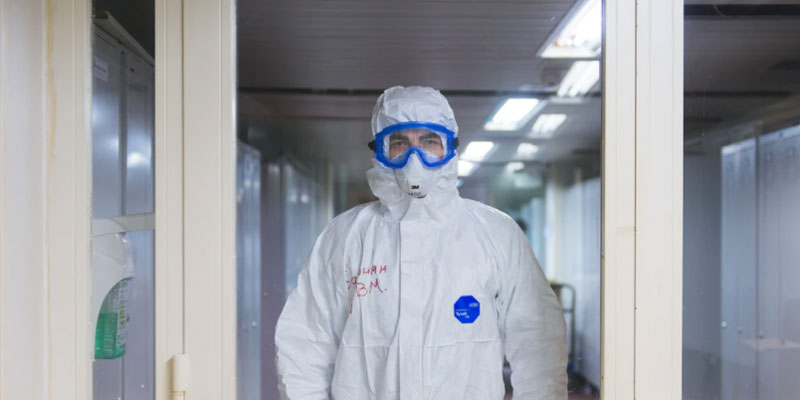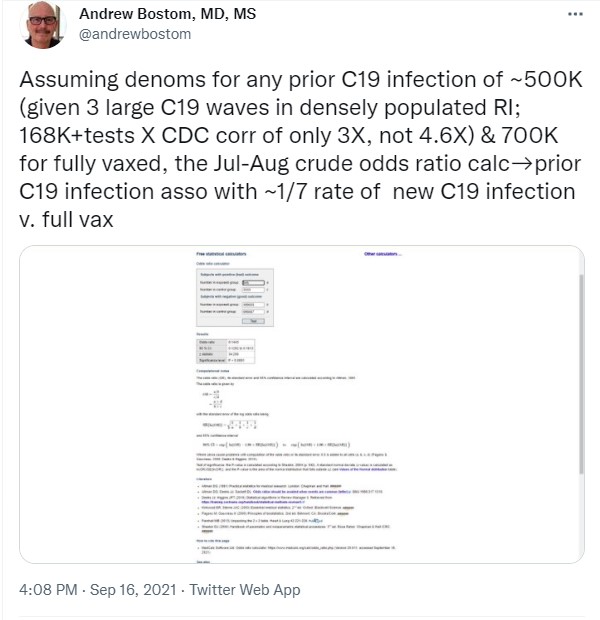
Natural immunity is better, but not as much as Bostom says.
Something about Andrew Bostom’s analysis of COVID-19 statistics keeps drawing me in, and my conclusion continues to be the same. Although he’s making reasonable points, and although his basic suggestions about policy remain correct, he repeatedly presents numbers as something they’re not in a way that overstates his case.
Here’s the latest tweet that drew me in:

What he’s saying is that the odds of catching COVID-19 again if you’ve already had it are 0.1443 (roughly one-seventh) the odds of catching COVID-19 if you’ve been fully vaccinated. You can flip that to say that somebody who’s vaccinated is seven times more likely to catch the virus than somebody who’s already had it.
Here’s the problem: There is overlap between those groups. He assumes 500,000 people have had COVID (many of them having never been tested) and 700,000 have been vaccinated, but many people have both had it and been vaccinated. If there are very few people who have been infected but who have not be vaccinated, then that alone could explain why very few such people tested positive over the summer.
Bostom makes no attempt whatsoever to estimate that number. Consequently, his odds calculation isn’t all that helpful, and even if we wanted to know these overlapping odds, once he assumes many more people have had the virus than show up as “cases,” he has to adjust his numerators, too, to go along with his changed assumption, and he doesn’t. A bunch of the people he’s reporting as first-time cases would actually be repeated cases.
The interesting question is: What are the odds of catching COVID-19 multiple times if you haven’t been vaccinated versus the odds of catching it for a first time if you have. That’s the comparison of natural immunity with vaccine immunity. This is where my inability to resist analysis comes in.
Let’s start with the cases for July and August that Bostom provides. Because we need some basis to estimate how many Rhode Islanders have had the virus without showing up in the numbers as “cases,” let’s go with a model from Columbia University that NPR reported in February as showing that five times more people had been infected than had been counted. This would mean 772,765 Rhode Islanders had already had the disease by the end of July. Luckily, we can stick with the reported number of vaccinations.
For our numerator of people who’ve been infected again, we therefore multiply the “repeat, non-vaccinated infections” by five, because many people counted as first-time cases should really be repeats, and we get 1,160. For the denominator, we multiply the total known cases by five and subtract the number of people we think were vaccinated even though they already had the disease. We’ll assume that prior infection had no effect on whether or not a person was vaccinated (which isn’t as unlikely as it sounds if we’re assuming most people who’ve had it didn’t know, or at least weren’t tested). So, we take the percentage of the population we estimate to have been infected and apply it to the number of vaccinations. That gives us 301,257 people who have had the virus, have not been vaccinated, and did not catch the virus again in July or August.
Now for those who’ve been vaccinated but never had the virus. In this case, we start with the number of people reported as vaccinated and infected for the first time and then subtract out all the extra people we think are actually repeat cases. This gives us a numerator of 2,768. For a denominator, we take the ratio of our estimated people who’ve never been infected versus the total population and apply it to the number of vaccinations, getting 170,310 Rhode Islanders who have been vaccinated and have never been infected.
If we plug these numbers into the online calculator that Bostom used, we get 0.2369, which means that your odds catching COVID-19 more than once if you haven’t been vaccinated are about 1/4 your odds if you’ve been vaccinated but never infected. That’s more in keeping with the numbers one sees here and there in public reports than Bostom’s 1/7.
Since we’ve come this far, we might as well answer the next important question: If you’ve already had COVID-19, how much do you improve your odds of avoiding getting it again if you get vaccinated? In this case, our 5x-cases estimate gives us a numerator of 565 people who’ve been infected again even though they were vaccinated and a denominator of 469,783 Rhode Islanders who have both natural and vaccine immunity and did not catch the virus in July or August. The calculator spits out 0.3123, which means if you’ve had COVID-19, your odds of catching it again if you’ve been vaccinated are about 1/3 your odds if you haven’t been vaccinated.
That’s a big improvement, but as I keep saying, your odds are good in any event. As far as the rest of us should be concerned, government forcing you to be vaccinated if you’ve already had COVID-19 is nuts.
Another interesting observation, looking at the numbers in this way, is how few people have neither type of immunity: just a little over 100,000. If that’s even close to correct, it’s simply foolish to exert government power to force vaccination and mask wearing. It’s also a mystery why public health officials are not, instead, pressing for immunity tests. It’s as if they’re choosing to reduce our knowledge of the virus in Rhode Island for some reason other than public health.
Featured image by Vladimir Fedotov on Unsplash.

good reasoning. i agree with you regarding Andrew. He’s on the right track but he’s got the bit between his teeth and he isn’t interested in criticism that could actually sharpen and strengthen his representations and provide prepartion for real engagement with those who will undercut them with ideological motive. When I engaged in critical discussion anticipating objection he cut off conversation. It’s one thing to say you don’t have time for every strap hanger who has some bone to pick but it is another to be dismissive of obviously valid critique. It unnecssarily undercuts the validity of what you say. This is certainly true of the rump of covidphobic medical establishment. Jha at brown makes me puke, but runs the show. For Bostom’s ideas to hold their own in the larger public discourse he needs to be better than Jha. That’s not hard but he’s missing the chance.
[…] Add people with natural immunity to the mix, which will put the number of people still at risk in a very different light. […]
[…] attitude is simply bizarre. Whether reading published reports or doing the math yourself, the conclusion is that natural immunity is preferable to vaccine immunity, yet the people making […]
[…] too, that we’re now back to another problem with Bostom’s analysis that we’ve explored before: Many of the people with natural immunity have also been vaccinated, which means the […]
[…] been pointing out for months that naturally acquired immunity appears to be stronger than vaccination, but that vaccination […]
[…] all of the former together, whether they’ve been vaccinated or not. I’ve pointed out before that this makes the numbers kind of meaningless. In a state where a large majority of people have […]